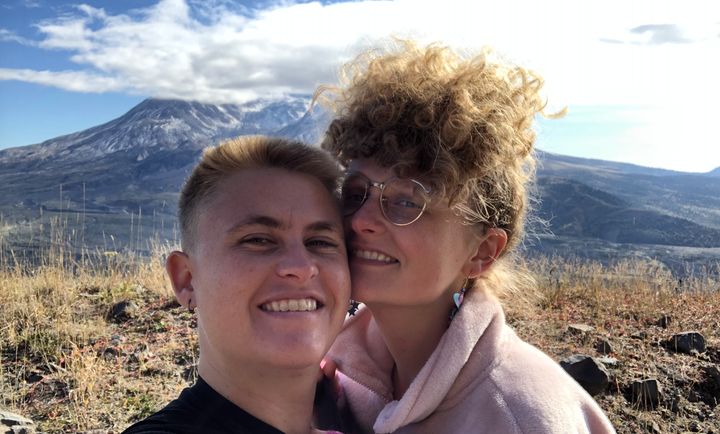
It’s a typical Saturday at 7 p.m. My partner takes out 25 feet of rope and tells me to lay down.
Half an hour later, I am face-down, fully clothed and completely calm, with my arms and hands bound tightly behind my back. My body is buzzing pleasantly and tingles run up and down my spine. My partner reclines in bed, drinking Red Bull, every so often checking my fingers to ensure my blood is properly circulating. These little checks are careful, consistent, verbal and nonverbal. We’re relaxed. Quiet. For the first time all week, I am exactly as immobile as I want to be.
When I’m ready to move again, my partner unties me, sliding the ropes along my skin and over the fabric of my T-shirt. I lean my full weight against her as the final knot is undone. She holds me upright for a moment, then lets me go. Gently, I roll out my shoulders, my neck, back muscles all the way down to wrists and fingers. There are cracks and pops and laughter.
I sleep really, really well on Saturdays.
These weekend ceremonies aren’t what people typically imagine when they hear the words “rope play” or “tie me up, baby.” Depictions of bondage in the media usually go like this: secret sex dungeons, hidden habits, men in business suits pulling out fluffy pink handcuffs with nervous laughter.
The media will have you quickly believe that rope play is only about sex, pain or exerting control over others. Sometimes it is. But for me, rope is a tool for crip empowerment.
Since the age of 21, I’ve fluctuated on a continuum of mobility impairment that even doctors can’t seem to pin down. Some days, I walk without issue. Other days, I’ll limp around all morning while watering plants, or maybe just when I’m tired at night, having stood too long. On easy days, I skip and play and go into the woods next to my house. On hard days and for big events, I use a wheelchair.
“The media will have you quickly believe that rope play is only about sex, pain or exerting control over others. Sometimes it is. But for me, rope is a tool for crip empowerment.”
With my body, the only certainty I can expect is uncertainty. Disability is unruly, unpredictable. It doesn’t look any one way, and for many people like me, disability is on a spectrum of visibility and severity. Pain and mobility issues affect every aspect of my life ― how I engage socially, personally, and how I can show up politically. I’m in a relationship with pain ― as a condition, as a lived reality, as a trauma, as an idea, as a politic ― in a way I’ll never be with another person.
I never know when I go to sleep if it’s thunder or pain that will wake me up. Writing to you now, I’ve had six long, hard weeks of consistent pain and rock-bottom stamina. Rainy days can stiffen up my joints and send shockwaves through my knees. But rain can also just be rain ― cool, refreshing, stunning to sleep to.
I will likely struggle with mobility for the rest of my life. To be restrained as a disabled person ― to have my mobility enthusiastically taken from me ― may seem like a contradiction. I am already restrained by the fact of my body, and more consequentially, by the institutions that ignore me, the medical establishment that wants to “fix” me or even venues that refuse to accommodate me. Given this reality, why would I choose to further limit my movements for fun?
My partner and I initially met for an interview. This was a year ago, and I was working on an interview series about queer spoonies ― a term for chronically ill or disabled folks ― and how they build networks of care and community via social media. The cafe’s AC was broken that day, and summer heat pumped through the windows and propped-up door. We sat across from each other over a shiny plastic table, sweating. Our conversation quickly turned from social media toward other tools of crip empowerment and connection. Carefully, she asked about rope. I took a sip of hot coffee.
“With rope, I turn toward not only my own body, but also toward the body of my disabled partner. This simple exchange is liberating.”
Rope play and bondage, for me, had always been linked to sexuality and pleasure. Before my disability, I experimented with bondage, but it felt more like foreplay ― something to get my blood pumping. After, I learned to think about rope play in terms of my mobility, the way it would fluctuate, the way I could begin to embrace those changes, and the way I might heal myself.
Now, getting tied up lowers my heart rate. My body and joints lean into cotton cords and I can feel a slow, slow pulse pounding in my body. To go beyond playful bondage toward a more intentional practice deepened my appreciation for the unpredictable, wild body I have. With rope, I turn toward not only my own body, but also toward the body of my disabled partner. This simple exchange is liberating.
It took that conversation over coffee, and eventually, to be tied up by another spoonie, to connect all the dots of my life: injury trauma, chronic pain and the bodily autonomy I was missing and what it sounded like.
“Tonight I need my hands and forearms tied together.”
“That sounds good. What parts of your body do I need to be careful with?”
“Don’t put any weight on my hips this time ... Could you do that a little bit looser?”
“How does that feel?”
“It’s perfect.”
I didn’t get to choose my mobility impairment. That choice was made for me by a distracted driver and an unlucky collision.
With rope, I do get to decide. I get to call the shots about how my body feels. I get to reclaim my own immobility by deciding when, where and how it happens. I get the privilege to experience everything I am otherwise denied: physical relaxation, predictability and steady expectations of ability.
These are novel, sacred experiences for me as someone who can never consent to how much pain I’m in or how far I can walk. In this way, rope becomes my tool of agency. The act of giving my limbs over to my partner becomes ceremony. When my body melts against rope, the sensation of restraint transforms into rest.
Have a compelling first-person story or experience you want to share? Send your story description to pitch@huffpost.com.
